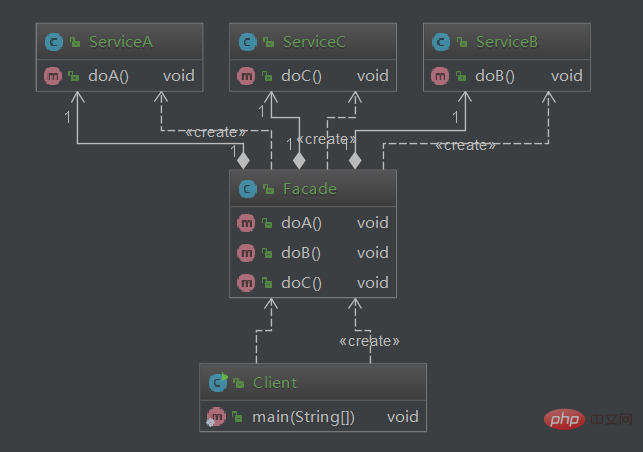
Okay, let’s get into our topic. Today Iwill share with you thefacade pattern# in the design pattern. ##.Use appropriate life stories and real project scenarios to tell the design pattern, and finally use one sentence to summarize this design pattern.
controller---servie---dao/mapper/repository
Today, Lao Tian will show you the facade mode.However, I have asked many people whether they are familiar with the facade mode? Some people have been working for five years and don’t even know.
English:
Provide a unified interface to a set of interfaces in asubsystem.Facade defines a higher-level interface that makes thesubsystem easier to use.
In fact, in daily coding work, we They are all using the facade pattern a lot, intentionally or unintentionally. Whenever a high-level module needs to schedule multiple subsystems (more than two class objects), we will consciously create a new class to encapsulate these subsystems and provide a streamlined interface so that high-level modules can more easily indirectly call the functions of these subsystems.
There are so many cases in life about the facade model.
Case 1: Go to the bank to handle business, and a front desk will receive you. Then, the front desk will ask you what business you need to do, and he will take you through it one by one, so that we don’t need to wander around and go everywhere. Find the corresponding business window. This front desk staff is equivalent to the facade model.
Case 2: When we build a house, if there is no contractor, you will have to find cement workers, electricians, decorators, etc. by yourself. But if you have a contractor, you don't have to do any of these tasks. You can tell the contractor directly that you need an electrician to fix the wiring. This contractor can be understood as a facade model.
Case 3: Thecontrollerdeveloped by our backend can also be understood as a facade mode. For example, to obtain user account information, first checkUserServiceto obtain user information, and then CheckUserAccountServiceuser account information.
In software systems, facade mode is suitable for the following application scenarios.
Still use code to implement a simple facade mode , because what we like most is to start with the demo.
Business scenario: Now we need to call the respective methods of the three services:
public class ServiceA { public void doA(){ System.out.println("do ServiceA"); } } public class ServiceB { public void doB(){ System.out.println("do ServiceB"); } } public class ServiceC { public void doC(){ System.out.println("do ServiceC"); } }
When the facade mode is not introduced, the client calls it like this:
public class Client { public static void main(String[] args) { ServiceA serviceA=new ServiceA(); ServiceB serviceB=new ServiceB(); ServiceC serviceC=new ServiceC(); serviceA.doA(); serviceB.doB(); serviceC.doC(); } }
Every Secondly, the client itself needs to create many service objects. If there are many services involved, wouldn't this code be very embarrassing? There will be a lot of repetitive code.
Run result
do ServiceA do ServiceB do ServiceC
Let’s addFacade mode:
public class Facade { //是不是很像我们controller里注入各种service? private ServiceA serviceA = new ServiceA(); private ServiceB serviceB = new ServiceB(); private ServiceC serviceC = new ServiceC(); public void doA() { serviceA.doA(); } public void doB() { serviceB.doB(); } public void doC() { serviceC.doC(); } }
The client becomes:
public class Client { public static void main(String[] args) { //轻轻松松的搞定,只需要创建门面这个对象即可 Facade facade=new Facade(); facade.doA(); facade.doB(); facade.doC(); } }
Run Result:
do ServiceA do ServiceB do ServiceC

Facade): Also called the facade role, it is the unified external interface of the system.
Service): There can be one or more
Serviceat the same time. Each
Serviceis not a separate class, but a collection of classes.
Servicedo not know the existence of
Facade. To the Service,
Facadeis just another client (that is,
Facadeis
ServiceA,
ServiceB,
ServiceCtransparent).
● Reduce system interdependence Think about it, if we don't use the facade mode, external access goes directly into the subsystem, and there is a strong coupling relationship between them. If you die, I will die, and if you live, I will live. Such strong dependence is the result of system design. Unacceptable, the emergence of the facade pattern solves this problem very well. All dependencies are on the facade objects and have nothing to do with the subsystem.
● Increased flexibility Dependence is reduced and flexibility is naturally increased. No matter how the subsystem changes internally, as long as it does not affect the facade object, you can move freely.
● 提高安全性 想让你访问子系统的哪些业务就开通哪些逻辑,不在门面上开通的方法,你休想访问到 。
违背单一职责原则。
在Spring中也是有大量使用到门面模式,比如说
org.springframework.jdbc.support.JdbcUtils
再来看看其中的方法
public static void closeConnection(@Nullable Connection con) { con.close(); } public static Object extractDatabaseMetaData(DataSource dataSource, DatabaseMetaDataCallback action) throws MetaDataAccessException { Connection con = null; try { con = DataSourceUtils.getConnection(dataSource); DatabaseMetaData metaData = con.getMetaData(); if (metaData == null) { //..... } return action.processMetaData(metaData); } } ......
都是给我封装好了方法,对于我们开发者来说,我只面向JdbcUtils这一个类就好了,我不用去管Connection、ResultSet等是怎么创建的,需要的时候,我调用JdbcUtils的对应方法即可获得对应的对象。
在Mybatis中也是用到了门面模式,比如:
org.apache.ibatis.session.Configuration
在Configuration中以new开头的方法,比如:
public Executor newExecutor(Transaction transaction) { return newExecutor(transaction, defaultExecutorType); } public MetaObject newMetaObject(Object object) { return MetaObject.forObject(object, objectFactory, objectWrapperFactory, reflectorFactory); } public ParameterHandler newParameterHandler(MappedStatement mappedStatement, Object parameterObject, BoundSql boundSql) { ... return parameterHandler; } public ResultSetHandler newResultSetHandler(Executor executor, MappedStatement mappedStatement, RowBounds rowBounds, ParameterHandler parameterHandler, ResultHandler resultHandler, BoundSql boundSql) { ... return resultSetHandler; } public StatementHandler newStatementHandler(Executor executor, MappedStatement mappedStatement){ ... }
对于调用这些方法的地方,他并不知道是怎么new出来的对象,只管使用就行了。
在Tomcat中也有门面模式,比如:
org.apache.catalina.connector.RequestFacade
从名字就知道它用了门面模式。它封装了非常多的request操作,也整合了很多servlet-api以外的内容,给用户使用提供了很大便捷。同样,Tomcat针对Response和Session也封装了对应的ResponseFacade类和StandardSessionFacade类,感兴趣的小伙伴可以深入了解一下。
PS:基本上所有以Facade结尾的类,都是使用到了门面模式。
Reference: Tom’s Design Pattern Course
Okay, I have shared so much about the facade mode. After reading this article, do you think that the facade mode is actually very simple? In addition, you can also consider whether it can be used at work. At the same time, it can also be used to brag during interviews.
The above is the detailed content of I have been working for five years and I still don't understand the facade model!. For more information, please follow other related articles on the PHP Chinese website!




